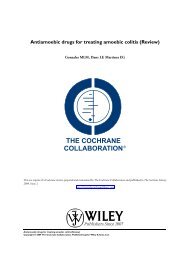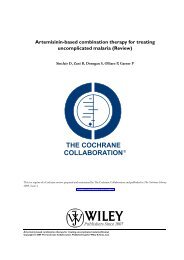Topical treatments for fungal infections of the skin and nails of the foot.
Topical treatments for fungal infections of the skin and nails of the foot.
Topical treatments for fungal infections of the skin and nails of the foot.
You also want an ePaper? Increase the reach of your titles
YUMPU automatically turns print PDFs into web optimized ePapers that Google loves.
against observed treatment failure rate in <strong>the</strong> o<strong>the</strong>r group. This<br />
was useful to illustrate <strong>the</strong> range <strong>of</strong> treatment failure rates among<br />
<strong>the</strong> trials, <strong>and</strong> <strong>the</strong> amount <strong>of</strong> heterogeneity between trials <strong>and</strong> sub<br />
groups. The diagonal line indicates no treatment effect (RR = 1).<br />
Points below this line correspond to trials where <strong>the</strong> treatment on<br />
<strong>the</strong> vertical axis has a lower treatment failure rate. The dashed line<br />
shows <strong>the</strong> pooled treatment effect. Each trial is plotted using a<br />
circle with size proportional to <strong>the</strong> st<strong>and</strong>ard error <strong>of</strong> <strong>the</strong> treatment<br />
effect so that trials providing more precise estimates are shown<br />
using larger circles.<br />
We listed non-r<strong>and</strong>omised controlled studies but did not discuss<br />
<strong>the</strong>m fur<strong>the</strong>r.<br />
Data syn<strong>the</strong>sis<br />
Statistical analysis<br />
The primary outcome i.e. rate <strong>of</strong> treatment failure, was extracted<br />
<strong>for</strong> three time points, considered to reflect clinically important<br />
timings. Each time point is analysed separately with sub comparisons<br />
within each treatment comparison consistently numbered as<br />
below.<br />
1. Short-term (two weeks): <strong>the</strong> order <strong>of</strong> preference was two, one,<br />
three weeks.<br />
2. Medium-term (six weeks): <strong>the</strong> time point closest to six weeks<br />
follow-up was used, provided that it was within four to eight weeks.<br />
If two time points equally close to six weeks were available <strong>the</strong>n<br />
<strong>the</strong> longer follow-up was used (e.g. eight ra<strong>the</strong>r than four weeks).<br />
Where a final follow-up endpoint with more participants included<br />
was available with four to eight weeks, this was used preferentially.<br />
Only > 80% follow-up included. A sensitivity analysis on<br />
<strong>the</strong> medium term data, restricted to data where <strong>the</strong>re was clear<br />
documentation <strong>of</strong> at least 80% follow-up <strong>of</strong> r<strong>and</strong>omised participants<br />
(where follow-up is given by group, at least 80% follow-up<br />
was required in both groups).<br />
3. Long-term (12 weeks onwards): longest follow-up <strong>of</strong> at least 12<br />
weeks.<br />
Sub comparisons were used to group toge<strong>the</strong>r <strong>treatments</strong> by duration<br />
(note that <strong>for</strong> short-term outcomes, grouping by duration<br />
was not necessary, since all durations were at least two weeks).<br />
Sensitivity analysis<br />
Sensitivity analyses were also conducted to examine <strong>the</strong> effects <strong>of</strong><br />
excluding studies with poor quality.<br />
R E S U L T S<br />
Description <strong>of</strong> studies<br />
See: Characteristics <strong>of</strong> included studies; Characteristics <strong>of</strong> excluded<br />
studies.<br />
Results <strong>of</strong> <strong>the</strong> search<br />
We considered all RCTs that evaluated topical <strong>treatments</strong> <strong>for</strong> <strong>fungal</strong><br />
<strong>infections</strong> <strong>of</strong> <strong>the</strong> <strong>skin</strong> <strong>and</strong> <strong>nails</strong> <strong>of</strong> <strong>the</strong> <strong>foot</strong>. For <strong>skin</strong> <strong>infections</strong><br />
we included only trials that used microscopy <strong>and</strong> culture to establish<br />
<strong>the</strong> presence <strong>of</strong> dermatophytes. For nail <strong>infections</strong> we included<br />
only trials that used culture to do so. We included duplicate trials<br />
only once. We excluded trials on <strong>fungal</strong> <strong>infections</strong> that contained<br />
data on <strong>infections</strong> at various body sites if <strong>foot</strong>-specific data could<br />
not be extracted separately.<br />
(a) Identified trials relating to <strong>skin</strong> <strong>of</strong> <strong>the</strong> <strong>foot</strong><br />
Included studies<br />
We identified 144 papers reporting trials <strong>of</strong> topical <strong>treatments</strong><br />
<strong>for</strong> <strong>fungal</strong> <strong>skin</strong> <strong>infections</strong> <strong>and</strong> included 67 (Ablon 1996; Akers<br />
1989; Aly 2003; Bagatell 1986; Bagatell 1991a; Bagatell 1991b;<br />
Bergstresser 1993; Berman 1992; Bojanovsky 1985; Carter 1972;<br />
Chretien 1980; C<strong>of</strong>fey 1986; Del Palacio 1989; Dobson 1989;<br />
Elewski 1996; Ellis 1989; Evans 1991; Evans 1993a; Evans<br />
1993b; Evans 1994; Friederich 1992; Fuerst 1980; Gentles 1974;<br />
Gomez 1986; Haas 1985; Hollmen 2002; Holti 1970; Ison<br />
1990; Izuno 1986; Kagawa 1985; Klaschka 1984; Kligman 1985a;<br />
Kligman 1985b; Korting 1997; Kuhlwein 1990; Ledezma 2000;<br />
Leenutaphong 1999; M<strong>and</strong>y 1974; Pereda 2003; Plotkin 1990;<br />
Qadripur 1979; Roberts 1985; Sanchez 1994; Satchell 2002; Savin<br />
1990; Savin 1994; Savin 1997; Schachner 1990; Schopf 1999;<br />
Smith 1977; Smith 1986; Smith 1988a; Smith 1988b; Smith<br />
1988c; Smith 1990a; Smith 1990b; Smith 1992; Spiekermann<br />
1976a; Spiekermann 1976b; Sushka 2001; Syed 2000; Tong 1992;<br />
Tschen 1997; Vermeer 1996; Weller 1998; Wosc<strong>of</strong>f 1986; Zaug<br />
1992).<br />
Comparisons<br />
<strong>Topical</strong> <strong>treatments</strong> <strong>for</strong> <strong>fungal</strong> <strong>infections</strong> <strong>of</strong> <strong>the</strong> <strong>skin</strong> <strong>and</strong> <strong>nails</strong> <strong>of</strong> <strong>the</strong> <strong>foot</strong>. (Review)<br />
Copyright © 2009 The Cochrane Collaboration. Published by John Wiley & Sons, Ltd.<br />
Twenty-nine trials compared a single active treatment with placebo<br />
(Akers 1989; Aly 2003; Bagatell 1986; Bagatell 1991a; Bagatell<br />
1991b; Berman 1992; Chretien 1980; C<strong>of</strong>fey 1986; Dobson<br />
1989; Evans 1991; Gentles 1974; Gomez 1986; Ison 1990;<br />
Izuno 1986; Klaschka 1984; Kligman 1985a; Korting 2001;<br />
M<strong>and</strong>y 1974; Savin 1990; Savin 1994; Savin 1997; Schachner<br />
1990; Smith 1977; Smith 1986; Smith 1988a; Smith 1990a;<br />
Spiekermann 1976a; Spiekermann 1976b; Tschen 1997).<br />
Twenty-five trials compared two active treatment regimens (<br />
Bojanovsky 1985; Carter 1972; Del Palacio 1989; Evans 1993a;<br />
Evans 1993b; Friederich 1992; Haas 1985; Holti 1970; Kagawa<br />
1985; Kligman 1985b Kuhlwein 1990; Leenutaphong 1999;<br />
5








